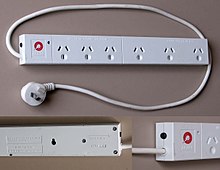If you have electronics, appliances or gadgets that you want to protect, make sure you get yourself some surge protection and this is not to be confused with a circuit breaker. They are two competley different devices for protecting again electrical currents.
So before you plug that fancy new computer or Playstation into a powerpoint, make sure you have at least basic surge protection from power strips, as it would be heartbreaking if your expensive new toy was to get fried by excess electrical power.
What Electrical Appliances Can Be Affected?
Surges and spikes can affect any electrical appliance but electronic equipment like computers, printers, microwave ovens, refrigerator, stereos, televisions, medical equipment, or communication equipment are most at risk.
Your telephone line can also be a source of power surges which can damage connected computers and fax machines.
What Is A Power Surge?
First off let's talk about what exactly it is.
A power surge is when there is a sudden increase in the amount of power or excess voltage is in the electrical system, and usually happens when high-powered items that are not constantly used like a lift creates an electrical surge.
While you can protect against these and most other types of surges, such as those caused by faulty wiring or damage done to the power supply when powerlines or the local power grid from a road accident or tree falling.
Thunderstorms can also cause a surge due to lightning strikes and these will overwhelm the power grid and in Brisbane and tropical Queensland, storms are a regular occurance.
Ways To Prevent Power Surges During A Thunderstorm
A spike in voltage during the storm season can be damaging to your ducted air conditioning system and other electrical components and connected equipment in your home.
This can often lead to expensive visits from electricians and the replacement of damaged household items.
The surge is caused by lightening strikes and can happen anywhere, so of course, it is best to be prepared for the worst, especially if it can save you in the long run.
If you can, unplug electronics during a storm and this will prevent sensitive electronic devices from being affected by a lightning strike.
There are three different options for surge protection:
Surge protectors aren’t magic. When they receive a power surge from the electrical outlet they’re plugged into, they have to do something with that extra voltage to get rid of it and shield the connected devices from it.
NOTE - That all Surge Protectors need to be replaced at some stage
They will have an indicator light that will either always be on if they are protecting electrical components or they may have two lights and they will signal if active or non active
If the surge suppressors are no longer working, what ever is plugged into the power will still work - BUT it will not be protected from another surge of excess energy.
- Portable. A Portable protection device such as surge protection powerboards plug into a power point and provide protection from power spikes for those appliances plugged into them. If you choose this option, you should consider purchasing a surge protection powerboard that has telephone protection included.
- Power point. These must be installed by a licensed electrician and replace a regular power point to provide specific protection for key areas in your home or business - for example for computers or phone/fax machines.
- Main switchboard. A surge protector or surge suppressors can be installed at your main switchboard by a licensed electrician. These will protect the entire house rather than just one power point or circuit.
Newer types are fitted with replaceable models that allow for quick replacement without the need for disconnecting the power.
These modules need to be replaced if there has been a surge.
They have an indicator which shows if an overload has occurred.
If the used protectors are not replaced they will not protect your appliances from damage if another surge happens.
You can install a Remore Signal Change Over - This is a warning light that is wired into your home or garage and it will come on when the surge arrestor in your switchboard needs to be replaced
Can I Prevent A Surge From Hapening?
Preventing them in your home requires some foresight and preparation.
Here are some steps you can take to keep your home and sensitive electronics safe:
Faulty or substandard wiring can make the problems worse. Have an electrician inspect your home's wiring for issues, especially if you have an older home.
Do you have an older air conditioning units?
They draw more power than the high-efficiency units on the market today. They are more likely to cause a power surge in your home when it suddenly stops drawing power.
A more-efficient model of AC unit will cut down on the risk of voltage spikes, and it also can save you money on your energy bills.
Unplug devices you aren't using
The easiest way to avoid power surge problems is to unplug electrical devices that aren't being used. Take a look around your home, and you'll likely find dozens of idle items plugged in.
There's no need to leave toasters, power tools or other small appliances plugged in; if you rarely use the programming features on your microwave or VCR, unplug those as well.
If you are going away for a time, unplug your appliances and this includes your hot water service. No power surge can damage an appliance that is not plugged in, and it is also a smart move for conserving energy as well as staying safe.
You should only be connected to a power source if there is a reason for you to be. Otherwise, disconnect and show some respect for your energy resources.
For more advice to protect your home and applicances from electrical damage call our Brisbane Electricians today

No comments:
Post a Comment